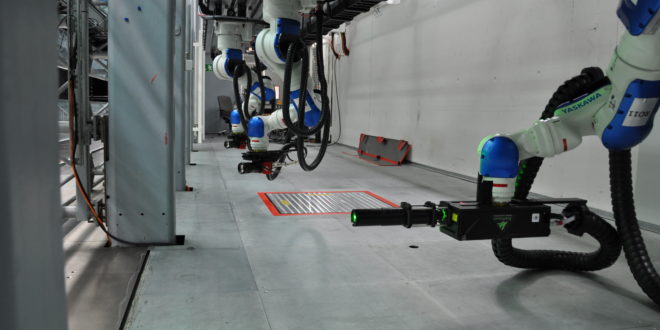A new method for measuring the aerodynamics of anything from an F1 car to a new aircraft design has been unveiled by a team of German scientists.
Their system, known as RoboPIV, uses a combination of robotic automation and particle image velocimetry to give a large increase in the efficiency of measuring flow velocity.
Writing in the journal Measurement Science and Technology, the team from specialist PIV company ILA_5150 in Aachen explain how the system can be deployed in a large scale, industrial environment.
Lead author Frank Michaux, managing director of ILA_5150, said: “Using PIV for large scale industrial projects is challenging. Design and production timeframes are short, and the cost of running large wind tunnels, combined with the need for special equipment and trained personnel mean PIV is not widely used in industry currently.”
In Formula 1, for example, wind tunnel testing time is limited by the sport’s regulations. This means the typical process of setting up the PIV equipment; calibrating; measurement, re-positioning the equipment; re-calibrating etc, takes up too much time from the available budget.
Co-author Dr Philipp Mattern, from ILA_5150, said: “Our RoboPIV system makes this process much easier, faster, and more accurate. We employ three robot arms, an integrated control system with a single interface, and real-time communication between all the elements.
“The robots can follow the motion of the wind tunnel model, creating new dynamic measuring possibilities. The complete sequence of measuring and processing the data is done without the need of any human interaction. This means the RoboPIV system provides high flexibility, and can take measurements in a fully automated way.
“In the tests we carried out for this study, taking measurements of the aerodynamic wake from a car mirror, we found using the RoboPIV reduced the time taken by at least a factor of three.”
The team’s system also allows for automated movement into a secured parking position during run-down of the tunnel, which clears the space and enables direct access and safe working conditions for staff.
Mr Michaux added: “These types of requirements for the flow measurement system are not restricted to Formula 1. There are natural applications for the technology to be used in the wider automotive industry, as well as aerospace and marine design and development.
“The PIV system needs to be able to run automatically without human interaction, and be
flexible enough to measure around the complete model – car, plane, boat – without the need for a new calibration process.
“This is exactly what our system achieves, without compromising the quality of the results in terms of accuracy and spatial resolution.”
The final version of RoboPIV: How robotics enable PIV on a large industrial scale by F Michaux et al (2018 Meas. Sci. Technol. 29 074009) available HERE.
 Engineer News Network The ultimate online news and information resource for today’s engineer
Engineer News Network The ultimate online news and information resource for today’s engineer






